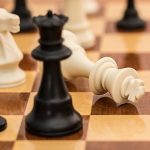Chess is a game that has been played for centuries and is enjoyed by people of all ages around the world. It is known for its strategic gameplay and requires players to think critically and use their intellect to outsmart their opponent. While the rules of chess may seem daunting to beginners, with the right guidance and practice, anyone can become a skilled player. In this blog post, we will provide a comprehensive guide on how to play chess from the basics to more advanced strategies. Whether you are a complete novice or looking to improve your game, we will cover everything you need to know to play chess like a professional. We will discuss the different pieces on the chessboard, their movements, and the basic rules of the game. We will also delve into more advanced concepts such as openings, tactics, and endgame strategies. By the end of this post, you will have a solid understanding of the game and the skills necessary to start winning games against other players.
1. Learn the basic rules first.
If you want to learn how to play chess, it is essential to start with the basics. Understanding the chess rules and chess pieces is the first step to becoming a good chess player. The game of chess is played on a square board with 64 alternating light and dark colored squares. Each player starts with 16 pieces: one king, one queen, two rooks, two knights, two bishops, and eight pawns. The goal of the game is to checkmate your opponent’s king, which means putting the king into a position where it is under attack and cannot escape capture. Before you start playing, you must first learn how each piece moves and how they interact with each other. The best way to do this is by studying the rules and playing through example games. Once you understand the basics, you can start to develop more advanced strategies and tactics to improve your chess game.
2. Set up the chessboard correctly.
The first step in playing chess is to set up the chessboard correctly. The chessboard consists of 64 squares, arranged in an 8×8 grid. Each player starts with 16 chess pieces, which include one king, one queen, two bishops, two knights, two rooks, and eight pawns. The chessboard should be positioned so that each player has a white square in the bottom right corner. The pieces should be arranged in a specific manner, with the rooks on the corners, the knights next to the rooks, the bishops next to the knights, the queen on her own color, and the king on the remaining square of the same color. The pawns are placed in front of the other pieces, with one pawn in front of each square in the second row. Following these chess rules, the chess game is ready to begin. It’s important to set up the chessboard correctly to ensure a fair game and to help players visualize their moves and strategies. Once the board is set up, players can begin learning how to play chess and enjoy the game.
3. Get to know the pieces.
To play chess, it’s important to understand the basic chess rules, chess pieces, and how to play chess generally. Once you’ve set up the chess game, it’s time to get familiar with the pieces. There are six different types of pieces in chess, each with its unique moves and abilities. The pieces include the king, queen, rook, bishop, knight, and pawn. The king is the most important piece as the objective of the game is to checkmate the opponent’s king. The queen is the most powerful piece, able to move in any direction, and is often considered the most valuable piece on the board. The rook moves horizontally or vertically and is often used to control important squares. The bishop moves diagonally and is best used to control long diagonal lines. The knight moves in an L-shape and is often used to jump over other pieces. The pawn is the weakest piece on the board, but it can be promoted to any other piece if it reaches the opponent’s side of the board. By understanding the roles and moves of each chess piece, you can develop effective strategies to win the game.
4. Start with the opening moves.
When it comes to learning how to play chess, the opening moves are crucial. They set the tone for the rest of the game and can determine the outcome. Before making any move, it’s essential to understand the basic chess rules and the functions of the chess pieces. Each player starts with 16 pieces, including one king, one queen, two rooks, two knights, two bishops, and eight pawns. The goal of the chess game is to checkmate your opponent’s king, which means that the king is in a position to be captured and cannot escape capture. To start the game, the player with the white pieces makes the first move. The most common opening moves are 1.e4, which advances the pawn in front of the king two spaces, or 1.d4, which advances the pawn in front of the queen two spaces. Starting with these moves can help control the center of the board and set up potential attacks. Understanding the opening moves is essential for beginners learning how to play chess.
5. Control the center of the board.
One of the most important chess rules to remember when playing the game is to control the center of the board. This means that you should aim to occupy and control the four central squares of the chessboard with your chess pieces. The center of the board is considered to be the most strategically important part of the chessboard as it provides greater mobility and flexibility for your pieces. By occupying the center, you can restrict your opponent’s movement and limit their options, making it easier for you to launch an attack. The king and queen are typically the most powerful pieces in the game, so it’s a good strategy to place them in the center as they can influence more squares from there. Remember, controlling the center of the board is a key component in how to play chess successfully.
6. Develop your pieces strategically.
To play chess effectively, it is essential to develop your pieces strategically. Each piece has a unique role to play in the game, and it is crucial to use them in a coordinated manner to achieve your objectives. The chess rules dictate that the pieces must be developed to their optimal positions to control the board and exert pressure on the opponent’s position. The chess pieces have different strengths and weaknesses, and learning how to leverage them is an essential aspect of the game. For instance, the pawn, the smallest chess piece, can be used to create a strong defense or to control the center of the board. The queen, the most powerful piece, can be used to attack the opponent’s position or to control key squares on the board. In combination with other pieces, the queen can be a formidable force. Developing your pieces strategically is a critical element of the chess game and can make the difference between winning and losing. To learn how to play chess, it is essential to understand the strengths and weaknesses of each chess piece and use them in a coordinated manner to achieve your objectives.
7. Watch out for your opponent’s moves.
“Watch out for your opponent’s moves” is one of the most important chess rules to remember. A chess game is essentially a battle of wits between two players, and each move made by one player will have an impact on the other. By paying close attention to your opponent’s moves, you can anticipate their strategy and plan your own moves accordingly. Remember to always consider the potential consequences of your own moves, and be prepared to adapt your strategy if necessary. Understanding the different chess pieces and how they move is also crucial to being able to predict your opponent’s moves. With practice and experience, you will become better at reading your opponent’s strategy and making the best moves to counter it. So, keep these chess rules in mind and stay focused on the game to become a better chess player.
8. Know the value of each piece.
When learning how to play chess, it is important to know the value of each piece on the board. This knowledge will help you make strategic moves and gain an advantage over your opponent. The chess rules dictate that each piece has a specific value, which is based on its ability to control space on the board and capture opposing pieces. The pawn, for example, has a value of 1 point, while the queen is worth 9 points. Understanding the value of each chess piece is essential to creating a winning chess game plan. By knowing which pieces are worth more, you can make informed decisions about which pieces to sacrifice and which ones to protect. Overall, taking the time to learn the value of each chess piece will greatly improve your chess game and help you become a skilled player.
9. Use tactics to gain advantage.
In the game of chess, players aim to outmaneuver their opponent’s pieces and ultimately capture their opponent’s king. One key strategy to achieve this goal is to use tactics to gain an advantage on the board. Tactics refer to specific moves designed to create threats, force trades, or gain material advantages. Some common tactics include forks, pins, skewers, and discovered attacks. To successfully use tactics, players must be able to identify and anticipate their opponent’s responses, as well as be aware of potential tactical threats to their own pieces. By mastering tactics and using them effectively, players can gain a significant edge in the game and increase their chances of winning. It is important to note that understanding chess rules, chess pieces, and basic chess strategies is essential before attempting to employ tactical maneuvers in a chess game.
10. Aim for checkmate to win.
In a game of chess, the ultimate goal is to capture the opponent’s king, or to put them in a position where their king is unable to escape capture. This is known as achieving a checkmate, and it is the only way to win the chess game. To achieve a checkmate, a player must use their chess pieces strategically, moving them across the board in a way that puts their opponent’s king in a position where it is threatened with capture. It’s important to remember that capturing the opponent’s pieces is not the ultimate goal – it’s simply a means to an end. By focusing on capturing the king, players can hone their skills and improve their chances of achieving a checkmate and winning the game. Whether you’re a beginner or an experienced player, mastering the rule of checkmate is an essential step in learning how to play chess. So, make sure to keep this in mind during your next chess game and strive to achieve checkmate to emerge victorious.
In conclusion, chess is a game that is both challenging and rewarding. By following the basic rules and strategies outlined in this post, you can start to develop your skills and improve your gameplay. Remember to always think several moves ahead, anticipate your opponent’s moves, and be patient. Practice is key to becoming a proficient chess player, so make sure to play as often as you can and study the games of other players. With time and dedication, you can become a master of the game of chess.







